Monday, July 28, 2008
Webinar Galore - 2 SPM Webinars Tomorrow
Callidus 7/29 @ 9A CST - Best Practices from Accenture - Align producer and advisor behavior, maximize mindshare - and effectively manage compensation
https://callidussoftware.webex.com/callidussoftware/onstage/g.php?d=570992696&t=a
Learn about insurance industry best practices from Jon Walheim - Accenture Partner - North America Insurance Marketing, Sales, and Service Lead. You’ll learn about key trends in the insurance industry, challenges that organizations are facing, and what insurance leaders are doing to gain competitive advantage.
Xactly 7/29 @ noon CST - The Business Case for On-Demand Sales Performance Management Analytics
https://www1.gotomeeting.com/register/415893690
In this Webinar, Xactly’s Karen Steele and THINKStrategies’ Jeff Kaplan will discuss how post-sales analytics can provide new and strategic insight into an organization’s selling patterns, commission spend, product performance, sales rep and team performance, and sales plan effectiveness. They will examine how post-sales data – traditionally scattered across a variety of disparate systems including ERP, HR, and Payroll – can be now be integrated and analyzed with an eye towards enhancing business strategies, changing sales rep behaviors, and super-charging sales organizations.
Friday, July 11, 2008
Incentive Compensation Industry News
- Subscription and support revenues for the second quarter are expected to be approximately $10.0 million, an increase of 68% over the second quarter of 2007.
- Callidus On-Demand (subscription) gross margins for the second quarter are expected to be within the range of 45 to 50%, up from 22% in Q1 2008.
WageWorks Selects Centive Compel(R) to Automate Sales Compensation Management
Centive, the leader in on-demandsolutions for sales compensation and sales performance management, todayannounced that WageWorks, the leading provider of tax-advantaged benefitsprograms, has selected Centive Compel to automate sales compensation and drivesales performance. Here is another related article.
Xactly Named World's Best New Company by 2008 International Business Awards(SM)
Xactly Corporation took home theprestigious International Stevie(R) Award in The 2008 International BusinessAwards.
Thursday, July 10, 2008
Popularity Burst
 I'm not sure what is happening to my search engine ranking on Google, but it has been climbing very quickly over the past few weeks! Here are a few examples as of this afternoon:
I'm not sure what is happening to my search engine ranking on Google, but it has been climbing very quickly over the past few weeks! Here are a few examples as of this afternoon:- Incentive Compensation: 10 (1st page!)
- Sales Performance: 17
- Enterprise Incentive Management: 20
- Incentive On-Demand: 7
- Incentive Offshoring: 2
- Incentive Compensation Implementation: 1 (woohoo!)
And that's not including all the vendor-specific keywords where I'm also ranking very well.
Thanks to everyone who kindly link to this blog. Your help in making it more visible is very appreciated. Please keep the comments, topic ideas and questions coming.
Julien
Tuesday, June 10, 2008
EIM Solution Maintainability - Should you care about this?
- correct defects
- meet new requirements
- make future maintenance easier, or
- cope with a changed environment
Why is Maintainability important?
The ability to modify a software system is obviously important for any type of system, but it is particularly important for an EIM solution. Why? Because compensation plans, organizational data, quotas, etc typically change at least once a year. Modifying this information is not a task equally easy to perform in all software packages.
 How to find out if a EIM solution is maintainable?
How to find out if a EIM solution is maintainable?
Any vendor will say their solution is maintainable... only an opinion from an unbiased person with experience implementing the particular EIM solution will be able to give a true account of how easy it is to maintain the application.
Effective dating plays a big role in maintainability. Being able to modify the information at anytime, but with changes effective only at a certain date, is critical to maintain a system.
Another key aspect of maintainability to consider the impact of year end on the plans. Some of the important information to find out is:
- Are the plans still going to work at year end?
- If plans need to be modified, how big of a change is it?
- How easy is it to modify the quotas?
- What about the rate / lookup tables?
- If formulas are embeded within the tables, do those need to be modified as well?
- How easy is it to move people in different positions?
- What do I do when people leave the company?
It is not atypical to see a somewhat complex logic which could be impacted by a simple change. For example, a formula referencing a table which contains another formula pointing to a quota. If the quota values can just be updated, it's not a big deal. If a new quota needs to be created, then the formula will also need to be updated to reflect the new quota.
Another example is when an EIM solution needs to be able to handle last year's orders at last year's rates. Depending on the system, this could mean creating new rules, new formulas, new tables, new quotas, etc.
It may not all be about the Product
Implementing a software package is a bit like custom development. A quality architecture results in the possibility to re-use components. Some programming languages are easier to maintain than others; as we discussed, the same goes for EIM solutions. However, no matter how good a programming language, a bad programmer can make the maintenance a nightmare. A bad EIM implementation team can also make the system's maintenance very hard, no matter how good the product is.
The bottom line:
Finding out the details about how maintainable an EIM solution is, is as important as finding out other characteristics such as how easy it is to implement it. You do not want to have to re-implement every plan every year; not only because it is time consuming, but also because major changes imply bigger risks.
The first part of the battle is to select an EIM solution which will make maintenance as painless as possible, but the battle is not won until the solution has been implemented properly.
Sunday, June 8, 2008
The Moral to the ICM Saga
 Read Part 1 and Part 2 of this story first.
Read Part 1 and Part 2 of this story first.The blame cannot be put on one person. ABC Corp, the ICM vendor and the consultant all own some of the responsibility for the issue.
The entire situation could have been avoided if the requirements had been better designed. Requirements could have been better designed if the compensation plans had been completed with enough details. The vendor would probably have done a better job at scoping out the work initially or in certain situations may even have not submitted a proposal.
What can we take away from this story?
- Requirements cannot be fully defined unless the compensation plans are finalized. Requirements may be inaccurate or incomplete unless compensation plans show sufficient details and examples.
- An ICM solution cannot be selected unless the requirements are fully defined.
- Not all ICM solutions can handle very complex compensation plans (no matter what the vendor's rep says). Some solutions are better suited for certain situations.
- Good requirements are the foundation for any IT project, mess up the requirements and the entire project will be shaky.
- Using an experienced consultant to help out with the requirements design, RFP writing and solution selection could be a good idea to select the ideal solution.
- Consultants and vendors alike cannot "always" guess client's intentions.
- Mentioning or emailing a requirement is not enough, this requirement must find its way to the requirement document to ensure it is met by the implementation and properly tested.
Thursday, June 5, 2008
The ICM Saga Continues...
 The vendor finally agrees that because the relationship between their companies is valuable and because of their strong work ethics, they will honor the agreed cost and do everything they can to meet the deadlines.
The vendor finally agrees that because the relationship between their companies is valuable and because of their strong work ethics, they will honor the agreed cost and do everything they can to meet the deadlines.However, problems keep piling up. The ICM solution is not intended to perform what would be required for the compensation plans to work how they are supposed to work. Data integration, workarounds and clever tweaking pushes the ICM solution to its limit. The client is asked to only include what is absolutely necessary in this release and push out the rest. The deadline is missed. The solution is finally implemented, but User Acceptance Testing keeps revealing new issues. The second pay-roll date is approaching but there is still no solution in sight.

Tuesday, June 3, 2008
The Saga of Purchasing an ICM System

Monday, June 2, 2008
Tweak your Sales Compensation Plan - A Tale of Diverging Opinions
 In case you are not familiar with it, the Canadian Professional Sales Association (CPSA) has an excellent magazine called "Contact". The best part is that this magazine is entirely available online, for free, and without any registration. Today I wanted to bring your attention to an article by Jay Somerset called "The Compensation Challenge" which appeared in the Contact Spring 2008 edition.
In case you are not familiar with it, the Canadian Professional Sales Association (CPSA) has an excellent magazine called "Contact". The best part is that this magazine is entirely available online, for free, and without any registration. Today I wanted to bring your attention to an article by Jay Somerset called "The Compensation Challenge" which appeared in the Contact Spring 2008 edition."It may be time to change - or tweak - your sales compensation plan to better compete in today's employee-driven market, but if it is done incorrectly you could send your sales team packing. "
Indeed, tweaking a sales plan is tricky business. Stats mentioned in the article back this up: Less than 10% of North American sales organizations redesign their comp plans in a given year, while the other 90 percent only perform minor tweaks. I think ideally, closer to 100% organizations should only perform minor tweaks. Redesigning a plan could be a sign that it had not been planned out properly, and sometimes organizations are compulsive about trying new plans rather than improving their existing plans by tweaking them.
Diverging Opinions
Greg Blysniuk, president of TopLine Sales Compensation Solutions in Toronto advocates simplicity. He says that sales managers often believe their compensation plans must be sophisticated and complex to compete; Greg believes one or two quantitative measures is all what is required to incent people and to ensure the plans are easy to understand.
David Johnston, president of Sales Resource Group Inc in Oakville, Ontario believes compensation plans should factor in qualitative metrics. "Qualitative metrics can be measured according to milestones or key events".
ICM Applications:
Greg says the main barrier to adopt an ICM application is their cost. He is in favor of using Excel spreadsheets for compensation data collection and analysis. He says that "Spreadsheets are simple to use, inexpensive and they do the basic job".
David does not agree; he says that spreadsheets are "too basic and error-prone". He also says that "sales is much too complex for a spreadsheet". He concludes that there is a middle ground with smaller-scale on-demand ICM applications such as PlanIt (which I reviewed previously), that do not require a large upfront cost.
The Bottom Line:
No matter which approach is used, I'm sure we can all agree that the goal is to make the compensation plans as straightforward as possible. If there is a valid reason for a plan to use some "complex" measurement, fine... as long as it's easy to understand and clearly communicated to the payees.
As for the need for an ICM application; if an organization is small enough with a low enough order volume and is happy with their current spreadsheet, and if they don't see any benefits in real-time analytics and dashboards, auditability, modeling, forecasting, and all the other benefits provided by an ICM solution, then there probably no incentive to replace the spreadsheet by such an application.
I agree with Greg that spreadsheets do the "basic job", but in my experience it does not take very long even for small organizations to realize that the "basic job" is not enough anymore to keep a competitive advantage.
Monday, May 26, 2008
For Love or Money: Social vs Monetary Reward
 Social Status and cash activate the same reward centre in the brain. That's what two papers in the latest Neuron journal (Volume 58, Issue 2) are saying. I'm always very interested by cognitive research attempting to explain how certain activities can affect human behavior.
Social Status and cash activate the same reward centre in the brain. That's what two papers in the latest Neuron journal (Volume 58, Issue 2) are saying. I'm always very interested by cognitive research attempting to explain how certain activities can affect human behavior.The article "Know Your Place: Neural Processing of Social Hierarchy in Humans" by Dr. Caroline Zink and colleagues explains how information about social status activated the same brain regions.
The second article "Processing of Social and Monetary Rewards in the Human Striatum" by Dr. Norihiro Sadato supports how reputation affects people in the same way as money does.
A subscription is required to read those articles, but they were summarized in ABC Science article "Praise or Cash? Your brain doesn't care".
Personal Story:
These studies support my own view on the topic. Last month I discussed the impact of the size of a money bonus on performance. It would be very interesting to see a similar experiment where some a group receive a lot of encouragement and the other group receives no praise at all, to compare their performance.
One of my previous employers, as many employers do, offered an annual performance bonus. This bonus was a percentage of the annual salary, but every employee received a very similar bonus. Employees developed a sense of entitlement to this bonus, and always thought they had met all their performance objectives and deserved the full amount. I'm just giving this context to illustrate how the cash incentive most likely did not have a positive impact on performance.
The employer, aware of this problem, introduced a "praise" program, consisting of recognizing employees who had made a significant contribution. Managers were encouraged to simply give a "Thank You" card to exceptional employees. I have no idea how this program affected performance... But it's impact on motivation was priceless.
Employees receiving these "praises" would shine for weeks. Common sense tells me that motivation can easily be correlated to performance. I can safely say that the thank you notes I received from colleagues I had helped during evenings and weekends really motivated me to keep working hard - there is nothing like feeling appreciated!
Another Story on Social Status
A few weeks ago I read an article about how job titles could be used to motivate employees, even if no pay increase is associated with the new title. I have a friend who had his job title changed from "Business Dev Manager" to "Manager, Entrepreneurship and Innovation Development". He's been jumping up and down since he got this "promotion". His reasons for being so happy: the title is unique, distinguishes him from his peers, and sounds better from his perspective.
Thursday, May 22, 2008
SPM Testing Template - Part 5
Here is an example to get started:
Other benefits of using an Excel spreadsheet to record test results instead of a Word document include:
- Ability to quickly highlight failing tests in red
- Ability to filter information displayed (e.g. display only failing tests)
- Test results can be printed on fewer pages
- Ability to create macros to perform more "fancy" features such as displaying the number of days a certain issue has been opened.
Monday, May 19, 2008
ICM Testing - Reviewing Results - Part 4
Every ICM application I have implemented offer an interface to browse through the results. This is usually a GREAT tool to troubleshoot and to resolve issues, but it's rarely the best and quickest tool to analyze results in bulk. Fortunately, every ICM application I have seen also have a functionality to export the results. Exporting the results will create a file locally which can then be opened by a program such as Excel or Access for further analysis. I will discuss how to use Excel to review the results, and later I will create another quick tutorial on using Access.
Step 1) Export the Results from your ICM System
Every system has its own way of doing this, but generally this should be doable from the interface and not requiring a database administrator to pull the data from the database (although this can also be done if required).
Step 2) Import the Data in Excel
First, open Excel and click on File->Open. Click on the dropdown menu beside "Files of type" and click on "All Files".
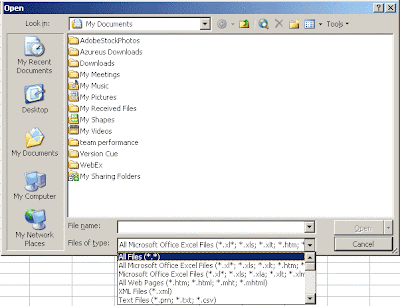 Find the location where you saved the exported file of step 1 and click on "Open".
Find the location where you saved the exported file of step 1 and click on "Open".If the file is a .CSV file, Excel will automatically place the data in columns. If the file is a .TXT file, more steps are required (see step 3).
Step 3: Opening a Delimited Text File in Excel
In the first Wizard step, choose "Delimited" and click on "Next". In Step 2, select the character used to delimit each column (Xactly uses semi-colons). Click "Next" twice and the data will be imported in columns.
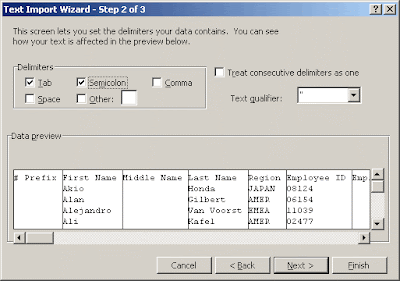
Step 4: Filtering the Result Data
At this point we have a worksheet with all of our result set displayed. Each of the column can be sorted and the search feature can be used to quickly find a specific order. However there is another trick which allows to quickly display data for a specific rule, result name, person, date, etc.
Click on Date->Filter->AutoFilter
This will make the first row (usually column names) dropdown menus which will contain all the values contained within the column. In the example below, the drop-down for column "Currency" allows to choose "USD" and "YEN". Choosing USD will filter out all the other currency types.
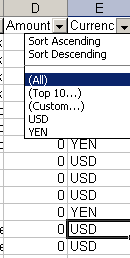
Filtering can be done in this manner for multiple columns at the same time. For example you could filter a certain position (Julien Dionne), and further filter to display only the USD currency.
Quick Summation
Summing credit and commission amounts is one of the most frequent activity I perform when testing.
Excel has a built in feature which allows to quickly find out the sum of selected cells. By simply highlighting the cells containing a number or a dollar amount, the total value of these cells will be displayed in the bottom-right corner of the window.
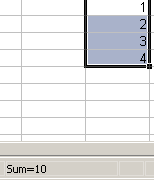
Additional Notes
Excel offers more advanced functionalities such as Pivot Tables. They can be useful when reviewing a large volume of results. I will discuss this in more details in the future.
Excel Limitations
Excel cannot have more than 65536 rows. If the result set exceeds this, it will not get imported. It is possible to "workaround" this issue by only importing a subset of data (maybe by restricting the incentive period). MS Access could also be used instead of Excel and would not be subject to this limit. I will discuss using Access to review results in the near future.
Thursday, May 15, 2008
ICM Test Planning, Scenarios and Templates - Part 3
 In my last post about testing I said that ICM / SPM systems should be tested in phases; the reason for this is that discovering issues late in the development life-cycle could add unexpected delays and ultimately make the budget run over-budget.
In my last post about testing I said that ICM / SPM systems should be tested in phases; the reason for this is that discovering issues late in the development life-cycle could add unexpected delays and ultimately make the budget run over-budget.Creating Test Scenarios for a Sales Performance Management System
I believe the most important aspect of testing is the test scenario preparation. I briefly mentioned how creating good test scenarios was particularly difficult with an ICM application because of the volume of test cases it will typically generate. This is unavoidable, but proper planning is required to ensure that tests are not testing the same conditions twice (wasting time) and that all conditions are being tested (not cutting corners).
Creating Test Data
The test data is the data that will be "staged" to test the scenarios. Typically, an order or a combination of orders will be required to test different scenarios. These orders should be created in the appropriate format to be staged and it should be documented which orders test which scenarios. Because of the different testing phases and because test data is often altered or corrupted during testing, it is important for the test data files to be kept together and be readily available to be re-staged when required.
After processing all the test data, all the test scenarios should be tested. That should cover the entire system, and in theory, after completing these steps, the system should have no outstanding defect.
Monday, May 12, 2008
Measuring Sales Force Performance (KPI)
 Google "Key Performance Indicator" and you will find enough KPI information to feel dizzy. It is important to know the difference between a performance indicator - some metric that we want to track - and the "key Performance Indicators" - or the most crucial performance indicators, those on which people are generally compensated on.
Google "Key Performance Indicator" and you will find enough KPI information to feel dizzy. It is important to know the difference between a performance indicator - some metric that we want to track - and the "key Performance Indicators" - or the most crucial performance indicators, those on which people are generally compensated on.A recent article “Measuring Sales Force Performance” at gulfnews.com gives a few examples of performance indicators.
Customer and product related Measures:
- Number of new customers acquired
- Sales by product
- Sales by customer segment
- New product sales
Process Measures:
- Productivity
- Channel mix
- Turn-around time
- Number of calls made
- Number of prospects generated
Financial Measures:
- Sales value by geography
- Profitability
- Cost of acquisition
- Attrition
- Book growth
- Fee Income
Measuring metrics is one thing, but interpreting all the data collected is essential and usually the biggest challenge. There are a lot of industry benchmarks that can be used as indicators of how the company is performing compared to their competitors. Measures can also be compared against some framework, analyst point of view or analytics.
However I think the author of the article is entirely correct when he says that internal benchmarks are better because “they tell you what the best team can do in the same situation”. I think that performance indicator’s most valuable insight comes from comparing the metrics against historical data.
Tuesday, May 6, 2008
Varicent SPM 5.0 - Interview with Varicent
 I know I said I would only present industry news once a week, but I wanted to take a moment to discuss the availability of Varicent’s SPM solution - SPM 5.0. I want to talk about this because I’ve received a few questions about it, and especially because following a good conversation with Kelley Kassa, Director of Corporate Communications and Rod Radojevic, Vice President Product Marketing I can offer a bit more information.
I know I said I would only present industry news once a week, but I wanted to take a moment to discuss the availability of Varicent’s SPM solution - SPM 5.0. I want to talk about this because I’ve received a few questions about it, and especially because following a good conversation with Kelley Kassa, Director of Corporate Communications and Rod Radojevic, Vice President Product Marketing I can offer a bit more information.Varicent SPM 5.0 is its flagship solution managing incentive compensation and sales performance. As with every other SPM solutions on the market, the value proposition is clear; Varicent SPM can predict costs associated with new plans, reduce errors, save time, reduce dispute resolution and administrative time of sales professionals, etc. More importantly, it can help out addressing the gaps existing between different business areas and departments.
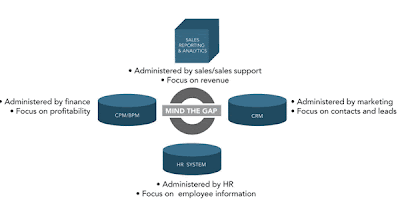 I had never seen Varicent SPM solution before this overview. It seems like most of the changes were done with the business user in mind.
I had never seen Varicent SPM solution before this overview. It seems like most of the changes were done with the business user in mind. 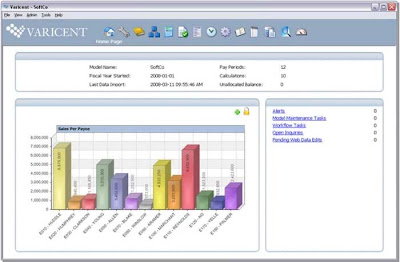 A new module called Composer was also introduced to this release. Rod pointed out that this module makes it easy for business users to set-up, manage and show rules and data flows. This workspace can give insight over calculations, territory assignments, credits, adjustments, overlays and exceptions. Rod added that the workflow appearance of this workspace makes it non-intimidating for anyone to jump-in and review the system.
A new module called Composer was also introduced to this release. Rod pointed out that this module makes it easy for business users to set-up, manage and show rules and data flows. This workspace can give insight over calculations, territory assignments, credits, adjustments, overlays and exceptions. Rod added that the workflow appearance of this workspace makes it non-intimidating for anyone to jump-in and review the system.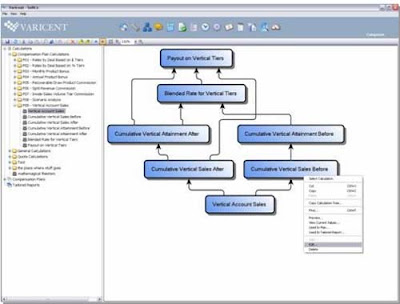
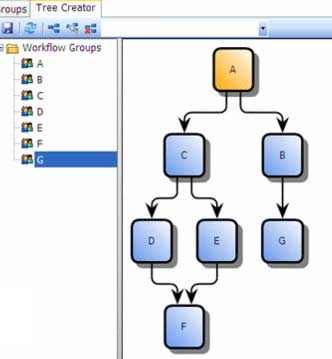
I asked Rod what makes Varicent SPM different from its competitors. We talked about its open architecture, its web analytics and reporting capabilities, its flexibility, scalability, and robustness. Rod also mentioned how Varicent was the first product to be a complete SPM solution, but I've seen this claim made by most other companies.

Overall, Varicent SPM 5.0 appeared to be very user-friendly and flexible, and seems to offer everything I would expect from an SPM solution.
If you have any other questions, please send them to me and I will gladly get an answer for them.
Monday, May 5, 2008
ICM Solution Return on Investment - Ask the Expert #4
David's Answer:
It’s a mystery. Since no one can conduct a double-blind test to confirm the value of sales compensation, we live in the world of anecdotes and observable behavior changes. My test of program effectiveness is the degree of “alignment” between product divisions and buyer/sales segments. The sales compensation program should ensure alignment of field efforts between these two moving parties.
What I have to say:
I talked about ICM ROI for the first time here, and discussed another story here. I agree with David that it is hard to assess if the new system is responsible for new behaviors. Taking this further, it is hard to assess whether a compensation program improves behaviors period.
However, assuming that a company does see benefits in an incentive program, the question is, will an ICM/SPM solution pay for itself. Presumably, positive behaviors are already encouraged by more labour incentive variable compensation. Real-time information, dashboards, accurate reporting and advanced analytics may help out sales people and management, but other factors are easier to quantify.
These factors are likely to depend a lot from one company to another. As I pointed out in the previous posts, some of the factors to consider are the implementation, licensing and upkeep costs, the quality of the existing system (how accurate it is), and the potential time saving to be realized with a new system (time spent calculating commissions, reviewing data, resolving issues, etc).
Wednesday, April 30, 2008
How to get an ICM / SPM Job?
- Get a job with a large Management/IT consulting company (such as IBM or Accenture) working in that area and have them train you. That's how I got there.
- Get a job with a consulting company specializing in these areas (either a large firm like Towers Perrin or a smaller firm like nGenera). This may be harder to do if you have no experience.
- Look at job boards for interesting jobs. There are often good opportunities posted on dice.com, and monster.com, etc. There are also specialized job boards such as the career opportunities page of World at Work and the Canadian Professional Sales Association's job board.
- If you have business or technical skills, you could look for any job with an SPM Solution Vendor and move into a consulting job.
- Get a related position in the industry; once you have a bit of experience, you can move on to a consulting company.
- Get some experience! Most vendors offer free Webinars, giving a good overview of their products. There are also dozens of books on the topic! If you can afford it, World at Work offer many courses and certifications. SPM software vendors also usually offer training on their products.
- If you are interested with the implementation aspect of ICM/SPM you could learn a Customer Relationship Management package such as SugarCRM. You may never use SugarCRM ever again, but at least it will be something to add on your resume (experience implementing an on-demand CRM software package).
- Participate to my blog, ask questions, build your knowledge.
- Click on my adds (just kidding)
- The most important recommendation last: Network, make contacts. Join a local professional chapter of World at Work or the CPSA... Attend all the conferences you can afford and introduce yourself to everyone you meet and have plenty of business cards to hand out.
- Contact me, I often hear about openings but I don't always have someone in mind to recommend. I may be able to help out and share your resume...
Tuesday, April 22, 2008
Sales Compensation Planning Made Easy - Interview with Makana Solutions
 I recently had the opportunity to spend an hour with Liz Cobb, Founder and CEO of Makana Solutions, and with Arthur Gehring, Director of Marketing.
I recently had the opportunity to spend an hour with Liz Cobb, Founder and CEO of Makana Solutions, and with Arthur Gehring, Director of Marketing.Makana is a relatively new company (founded in 2004) offering a very good on-demand application, called Makana Motivator, which helps build effective and clear compensation plans. Makana Motivator is very easy to use and allows its users to quickly create a plan either based on other sample plans, or from the ground up. It also has the capability to “test” your plan.
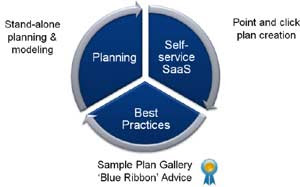 As I mentioned several times, one of the biggest challenges faced by sales management or consultants when implementing a sales compensation system is the “complexity” of the compensation plans. Sometimes compensation plans are quickly described in a e-mail or over the phone, or almost handed over written on a napkin. In other scenarios, they are can be well documented but may still lack clarity, key aspects, or examples, or may be lengthy. Finally, even if a compensation plan is well documented, it does not mean that the plan is effective and well aligned with the objectives and budget of the company.
As I mentioned several times, one of the biggest challenges faced by sales management or consultants when implementing a sales compensation system is the “complexity” of the compensation plans. Sometimes compensation plans are quickly described in a e-mail or over the phone, or almost handed over written on a napkin. In other scenarios, they are can be well documented but may still lack clarity, key aspects, or examples, or may be lengthy. Finally, even if a compensation plan is well documented, it does not mean that the plan is effective and well aligned with the objectives and budget of the company.The Makana Motivator application is very intuitive to use. Companies using the application typically receive a 1-hour live tutorial from Makana, after which they are able to model plans on their own. The main components of the application consist of the space in which the plans are built, where the organization is built with assignments and territories (participants can be imported from SalesForce.com), a section for cost modeling the plans, and finally, a section that generates a plan and gives the option to save it as a PDF.
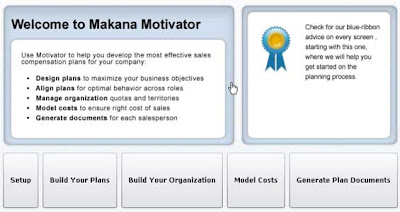
In my opinion, one of the most powerful aspects of Makana Motivator is that it allows users to choose templates from a best-practice library and to adapt them to meet individual circumstances. The application then guides the user following a “wizard” step-by-step approach to ensure nothing is overlooked. The application is very interactive; hovering over most of the application components provides additional feedback . “Blue-ribbon advice” offering expert tips and help is also available throughout the process.
Another important feature of this application is the ability to display and compare plans side by side. Such a graphical representation quickly helps identify the major differences between plans.
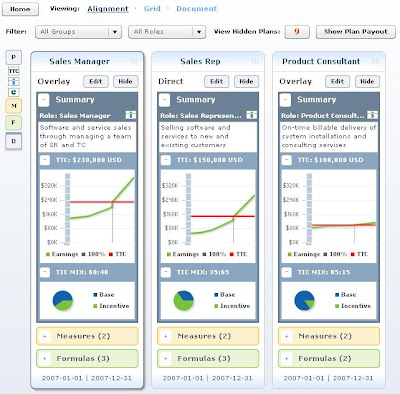
Plans are not only displayed side-by-side; they can also be designed and modified side-by-side. Plans consist of measures and formulas which can be edited by expanding their respective section.
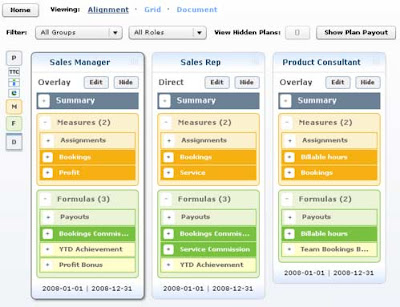
The cost modeling section can show costs for the entire company or byany sub-set such as product group or geography. Projected attainment can be modified to gain an idea of the impact of those variables on the overall incentive costs. Many sales performance management applications offer modeling and analytics capabilities, but Makana Motivator allows its users to model the plans BEFORE they are implemented rather than after, which can save a lot of time, money and headaches.
Once the plans are fully designed, and since the application is on-demand; they can easily be circulated and feedback can be gathered directly in the application. Upon acceptance of the plans, plan documents can be individualized and generated. The resulting plans are very clear and easy to understand by consultants, comp teams and sales reps alike, and are visually pleasing.
Motivator adds a lot of value over the spreadsheets used for planning today by streamlining the process, providing best practice guidance, easy cost modeling, clear plans and an audit trail. Makana Motivator also provides Salesforce.com users Apexchange certified integration.
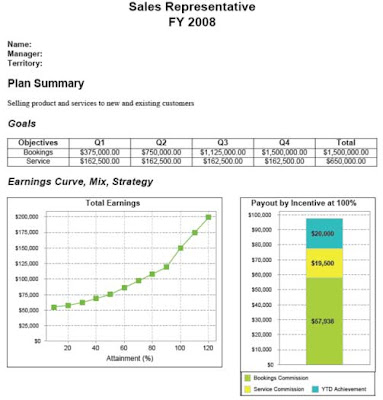 Read more about what customers have to say about Makana Motivator.
Read more about what customers have to say about Makana Motivator.After completing a form on the Makana website, you can access several free webinars and articles about Makana Motivator and compensation plan design best practices.
Monday, April 21, 2008
Do Big Money Bonuses Really Increase Job Performance?
The summary of the paper on the PsyBlog seemed a bit counter-intuitive. Most companies around the world would most likely not have some flavor of a pay-for-performance program if a bonus was actually decreasing performance.
So what is happening? On one hand, I think that if the bonus is very high, participants could have been really stressed out about the task and not performing as well because of that pressure. It is also possible that performance decreased because participants did not actually believe they would receive the bonus for a variety of reasons – sometimes when only a certain number of people can receive the max bonus, participants feel they don’t have a chance to perform at the required level and behave accordingly. Even if there is no maximum number of participants who can receive the largest bonus, the performance required to get the bonus could be perceived as being unattainable or not worth it.
The relative value of bonuses versus the effort required to obtain them is another factor which could affect the participant’s behavior. If working exceedingly hard is required to get the max bonus but that only a moderate amount of work is required to get a bonus which is only slightly inferior, many participants could be settling for the smaller bonus.
I spent some time looking for other papers on this topic and found a few other possible explanations. The “crowding out” theory supports the hypothesis that incentive pay decreases employees’ motivation to perform up to abilities. The explanation generally given for this is that the introduction of an obligatory amount of output to produce is often considered by employees as a signal of distrust. The papers I found discussing the crowding theory are: Titmuss (1970), Rothe(1970), Gneezy and Rustichini (2000), and McNabb and Whitfield (2003). Papers by Kruse (1992), and Ichniowski and Shaw (2003) “prove” that incentive pay positively affects employees’ effort.
As for me, based on my own observations and “empirical evidence”, I will side with Kruse, Ichniowski and Shaw to say that incentive pay (if used properly) can positively affect employees’ performance.
Thursday, April 17, 2008
Spiffs, Bonuses and Contests - Ask the Expert #3
In this 3rd installment of David Cichelli's "Ask the Expert" series on this blog, I asked David about his thoughts on spiffs. I asked him if it was possible to use spiffs while avoiding encouraging employees to push a certain product upon a customer at his or her expenses. I also asked David if there was such a thing as too many spiffs. Previous posts of this series are here and here.
Before going into David's answer, I want to give a bit of background regarding what is a spiff.
SPIF (or SPIFF) may stand for "Sales Performance Incentive Fund", "Special Performance Incentive Fund" or " Special Performance Incentives for Field Force". The exact origin of the term is open for debate. Wikipedia defines a spiff as a small, immediate bonus for a sale. They can be paid by a munufacturer or the employer, to the salesperson who sold a specific product.
I have seen spiffs used in several scenarios such as when a manufacturer wants to gain market adoption with a new product, when a retailer wants to liquidate some of its inventory, to incent sales people to sale certain combinations of widgets, etc. The goal is always to have an immediate impact on sales force behavior. Of course, spiffs are not without their own pros and cons, but they can fit nicely within a compensation strategy.
Here is what David had to say about spiffs:
Julien, you might want to check the spelling of “spiff.” I spell it with one “f.” It means Special Performance Incentive Fund. Check Wikipedia for a nice discussion on the spelling. [Sorry David - I'm sticking to spiff for now, so far I've seen it spelled this way more often than "spif"].
First of all, I consider spifs, contests and campaigns an integral part of the sales management’s tool kit. Here are the rules for appropriate use of these programs:
- Budget of all programs should not exceed the total earnings of the sales force by 3% .
- Spifs should be used for “doing something new for the first time.”
- They should not be used to spike performance during a period.
- They are narcotic in nature: the more you use them the more you need to use them. Moderation of use with healthy hoopla is the best prescription for success.
- Avoid the use of “chance” to determine winners and payouts--it 's unethical to do so: this is an employment relationship, not Las Vegas.
Tuesday, April 15, 2008
Ready... Set... Go-Live!
Before an ICM implementation can be deployed, there are a number of things that need to be done. "Go-Live" refers to an implementation being transitioned from being developed and tested, to being used in production. An application that is "in production" means that it is now used with real data, to pay real people, and bugs, errors and overpayments are not an option.
Meeting the go-live date when building an ICM solution is particularly important because those dates are often related to pay-roll cycles and are often less flexible than other type of systems.
With tight deadlines and little tolerance for mistakes, go-lives are the most stressful moment for anyone involved on the project. No matter how good the relationship with the client and how well the implementation went, if go-live is not successful, executives can get bitter, people can get fired, and all the hard work put in the project can be forgotten.
Implementing different applications require different steps to go live. An on-premise application will have more steps such as migrating the application from the development hardware onto the production hardware and making sure this hardware conforms to the development/test environment. For a SaaS solution there are less steps, migration is usually easier and there is no need to worry about hardware.
What is most stressful for a consultant during the go-live phase is that it's the ultimate milestone; the system must be rolled-out, and the implementation must be completed and functional. The User Acceptance Test (UAT) must be performed on the system and signed-off. UAT is essential to capture the client's agreement that the implementation performs as desired.
With all that is involved in the go-live phase, consultants will work 80-100 hours a week to make it happen; it’s "crunch-time"!
Here are a few ideas of items to include on your ICM go-live check list:
- Setup and test all relevant hardware (if on-premise)
- Ensure updated documentation exists and that users are trained.
- Ensure a roll-back strategy is in place in case there is a ‘show stopper’
- Ensure vendors and consultants are available during go-live period
- Backup any existing configuration
- Install, test and configure all required software, including the creation of a production database
- Migrate all reference data such as order types, credit types, calendars, business groups, users, rolls, etc.
- Migrate all organization data such as positions, titles, hierarchy, territories, customers, relationships, etc.
- Migrate all plan artifacts such as plans, rules, formulas, tables, quotas, etc.
- Migrate any other objects such as reports, draws, documents.
- Ensure any script or data integration items are migrated / updated to reflect the environment change
- Migrate all the required data to the new database
- Test new system rigorously
- Obtain sign-off on results (same results as user testing)
I haven't written on my blog in the past 2 weeks because I am just in the process of going live with 2 projects at the same time, for 2 different clients. Please be patient, I will start writing again soon.
Blog Search
Subscribe
Other Resources
Blog Archive
Tags
- Sales Performance Management (34)
- Incentive Compensation (27)
- Callidus (19)
- Xactly (17)
- Industry News (15)
- SaaS (15)
- Sales Compensation (14)
- Incentive Strategy (12)
- On-demand (11)
- Best Practices (10)
- Centive (9)
- Case Study (8)
- Webinar (8)
- Varicent Software (7)
- Applications (6)
- Compensation Plans (6)
- ICM (6)
- Incentive Compensation Management (6)
- Pros and Cons (6)
- David Cichelli (5)
- IT offshoring (5)
- News (5)
- Technical Tips (5)
- Testing (5)
- Accenture (4)
- Enterprise Incentive Management (4)
- Implementation (4)
- OpenSymmetry (4)
- RFP (4)
- Return on Investment (4)
- Synygy (4)
- Variable Compensation (4)
- outsourcing (4)
- Analytics (3)
- Ask the Expert (3)
- Consultant (3)
- Funny (3)
- Humor (3)
- IT outsourcing (3)
- Information (3)
- Makana (3)
- Performance Measurement (3)
- Procurement (3)
- Research (3)
- SalesForce.com (3)
- nGenera (3)
- Banking (2)
- Bonus (2)
- Compel (2)
- Excel (2)
- Gartner (2)
- Greg Livengood (2)
- Ice-breaker (2)
- Implementation Partner (2)
- Incentive Plans (2)
- Merced Systems (2)
- Offshore (2)
- On-premise (2)
- Opinions (2)
- Personal Story (2)
- Practique Associates (2)
- Review (2)
- SPM (2)
- Sales Resource Group (2)
- SuccessFactors (2)
- Template (2)
- "Canadian Professional Sales Association" (1)
- "Dig your Well before you're Thirsty" (1)
- "Don Tapscott" (1)
- "Effective Dating" (1)
- "Harvey Mackay" (1)
- "Incent 4.0" (1)
- "Jay Somerset" (1)
- "Keith Ferrazzi" (1)
- "Never Eat Alone" (1)
- AskJon (1)
- BSG Alliance (1)
- Benefits (1)
- Blog (1)
- Book Review (1)
- Boutique Consulting (1)
- Bradford Smart (1)
- Business Process Reengineering (1)
- CPSA (1)
- Challenges (1)
- Coaching (1)
- Compensation Architect (1)
- Competency Management (1)
- Configuration Management (1)
- Consulting (1)
- Contests (1)
- Cygnal Group (1)
- Dashboard (1)
- Deployment Checklist (1)
- Donya Rose (1)
- EIM Software (1)
- Effective Dating (1)
- Enterprise 2.0 (1)
- Eran Carmel (1)
- ForceLogix (1)
- Gary Harpst (1)
- Global Workforce (1)
- Glossary (1)
- Go-live (1)
- Greg Alexander (1)
- HCM (1)
- HR Carnival (1)
- ICM Solution (1)
- Iconixx (1)
- In-house Development (1)
- Incentive Compensation Glossary (1)
- Insurance (1)
- Integration (1)
- Interviewing (1)
- Jeff Kaplan (1)
- Job (1)
- Job Evaluation (1)
- Jon Ingham (1)
- Jon Walheim (1)
- Julien Dionne (1)
- KPI (1)
- Leapcomp (1)
- Livengood Consulting Group (1)
- Maintainability (1)
- Management (1)
- Methodology (1)
- Metrics (1)
- Migration (1)
- Motivator (1)
- Naming Convention (1)
- Networking (1)
- Offshore Communication Challenges (1)
- Offshoring Information Technology (1)
- Optimization (1)
- Oracle (1)
- PPM (1)
- Paul Tjia (1)
- Pervasive Performance Management (1)
- Plan Design (1)
- PlanIt (1)
- Prediction (1)
- Press Release (1)
- Professional Networking (1)
- R (1)
- Reporting (1)
- SPM Question (1)
- Sales Performance Management Outsourcing (1)
- Santorini Consulting (1)
- Six Disciplines Execution Revolution (1)
- Spiff (1)
- Sungard (1)
- THINKStrategies (1)
- Talent (1)
- Terminology (1)
- TextPad (1)
- Topgrading for Sales (1)
- Towers Perrin (1)
- TrueTarget (1)
- Truecomp (1)
- Tutorial (1)
- Vendor (1)
- Ventana Research (1)
- Version Control (1)
- Visa (1)
- Wikinomics (1)
- competitive advantage (1)
- sales rep (1)
About Me

- Julien Dionne
- Ottawa, Ontario, Canada
- Julien Dionne is a well-rounded consultant with global business management experience and outstanding technical, business and leadership skills. He earned a Bachelor of Applied Science in Software Engineering from the University of Ottawa, Canada, and he is a member of the Canadian Professional Sales Association. The views posted within this blog do not reflect the views of Julien’s current or previous employers and clients. Julien can be reached at julien.dionne@gmail.com










